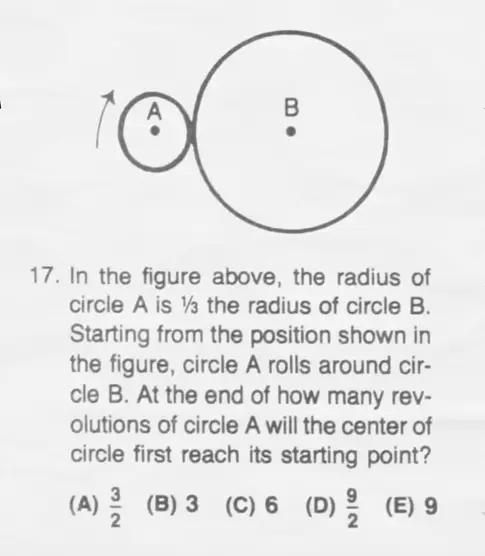The Coin Rotation Paradox
A peculiar SAT question
Veritasium released a video recently on a very curious paradox that I found quite unintuitive at first. The paradox relates to the following SAT problem from 1982.

Rotations
0
I recommend pausing here and picking an answer before continuing.
The obvious answer here seems to be (B) 3 rotations. You divide the circumference of the large circle, with the circumference of the small circle, both of which are proportional to their radius. Since A has 1/3rd the radius, it does 3 whole rotations before returning back to its start position. Yet, if you try this out in person (or press Start on the simulation above) you find that the actual number of rotations is 4 - which isn’t even present as a possible choice on the question!
Even more interestingly, if you flatten out the large circle, and then count the number of rotations observed, then you find to it be three again, as initially expected!
Rotations
0
This is quite surprising. So why is it 4, and not 3, as we would expect? In fact, the correct answer for any pair of circles of radius
Of the 300,000 students who took the SAT in 1982, only three wrote in informing the board of this mistake. One of those three students, Doug Jungreis - now a full professor of Mathematics - appeared in Derek’s Veritasium video to provide an interesting mathematical explanation for why this is the case. His explanation relied on the observation that the amount the small circle rotates is equal to the distance traveled by the centre of the circle. And since the centre of the circle is one radius of A further away from the centre of B, this distance travalled is the circumference found by adding the two radius' together, which results in one additional rotation. So the answer is always equal to the ratio of the two radii plus one.
This is a very elegant mathematical explanation - which also generalises to polygons, or moving along an interior - but for me at least, doesn’t quite scratch the itch on what drives this phenomena intuitively.
I think one of the best ways of grokking this phenomena intuitively is to note that rotation of the small circle can be decomposed into two parts. The first, is the component that arises from travelling the length of the larger object - whether this a circle or a polygon. This component gives rise to the 3 rotations expected in the original question, and is equal to the perimeter of the larger object divided by the circumference of the rotating circle. The second component comes from the curvature of the surface itself, upon which it is rotating. One can say that the circle is rotating on a path which is itself rotating inward into itself, and crucially, this secondary rotation does not ‘use up’ any of the additional circumference of the circles.
Rotations
0
To see this second point more clearly, consider this phenomena when it occurs on a polygon. If you watch the movement of the small circle as it reaches each corner of a polygon, we see that it sweeps out some additional angle while the point of contact between the polygon and the smaller circle stays the same. We know that the external angles of a regular polygon are equal to
A circle is simply a regular polygon with a number of sides going to infinity. In the case of a circle, if we want to understand the additional angle rotated at each point we have to talk in the language of derivatives, since we are talking about an infinite number of infinitesimally small sides. The additional angle rotated at each point is equal to the derivative of the angle of a tangent to the large circle at that point, multiplied by an infinitesimally tiny amount of the path. Integrating this over a full revolution around the large circle, gives us
Where
This also explains why a smaller circle rotating inside a larger circle has 1 less rotation than expected: because the derivative of the tangent angle with respect to the position of the small circle is negative, since a circle rotating clockwise inside a larger circle actual follows a counter-clockwise path within the larger circle. Or in other words, the counter-clockwise curvature of the path, counteracts the clockwise rotation of the small circle by exactly one.